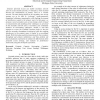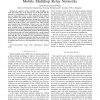WIOPT
2010
IEEE
13 years 10 months ago
2010
IEEE
Abstract—Development of dynamic spectrum access and allocation techniques recently have made feasible the vision of cognitive radio systems. However, a fundamental question arise...
TCOM
2010
13 years 10 months ago
2010
Abstract—This paper considers an uplink time division multiple access (TDMA) cognitive radio network where multiple cognitive radios (secondary users) attempt to access a spect...
INFOCOM
2010
IEEE
13 years 10 months ago
2010
IEEE
Abstract—We consider a cognitive radio network where multiple secondary users (SUs) contend for spectrum usage, using random access, over available primary user (PU) channels. Ou...
MONET
2006
13 years 11 months ago
2006
Enabled by regulatory initiatives and advanced radio technology, more flexible opportunistic spectrum access has great potential to alleviate the spectrum scarcity. In this paper,...
JSAC
2008
13 years 11 months ago
2008
We propose the cross-layer based opportunistic multi-channel medium access control (MAC) protocols, which integrate the spectrum sensing at physical (PHY) layer with the packet sch...
CORR
2007
Springer
13 years 11 months ago
2007
Springer
—In cognitive radio (CR) networks, there are scenarios where the secondary (lower priority) users intend to communicate with each other by opportunistically utilizing the transmi...
GLOBECOM
2009
IEEE
14 years 2 months ago
2009
IEEE
Dynamic Spectrum Access can enable secondary network users to access unused spectrum, or whitespace, which is found between the transmissions of primary users in a wireless networ...
GLOBECOM
2007
IEEE
14 years 3 months ago
2007
IEEE
We design opportunistic spectrum access strategies for improving spectrum efficiency. In each slot, a secondary user chooses a subset of channels to sense and decides whether to ac...
WCNC
2010
IEEE
14 years 3 months ago
2010
IEEE
Abstract—In cognitive mobile multihop relay (CMMR) network, the mobile user as the primary user is allocated with the channel for transmitting data. Relay station as the secondar...
ICC
2007
IEEE
14 years 5 months ago
2007
IEEE
We consider opportunistic spectrum access for secondary users over multiple channels whose occupancy by primary users is modeled as discrete-time Markov processes. Due to hardware...


